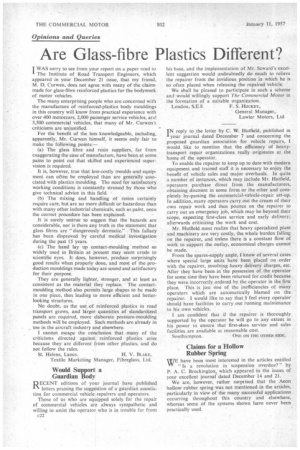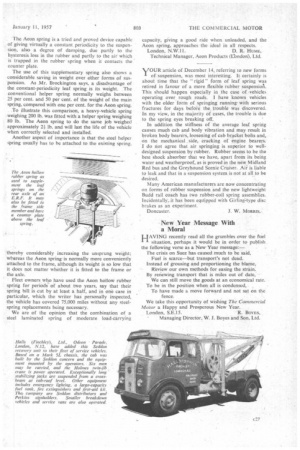Are Glass-fibre Plastics Different?
Page 60

Page 65

If you've noticed an error in this article please click here to report it so we can fix it.
I WAS sorry to see from your report on a paper read to The Institute of Road Transport Engineers, which appeared in your December 21 issue, that my friend, M. D. Curwen, does not agree with many of the claims made for glass-fibre reinforced plastics for the bodywork of motor vehicles.
The many enterprising people who are concerned with the manufacture of reinforced-plastics body mouldings in this country will know from practical experience with over 400 motorcars, 2,000 passenger service vehicles, ard 3,500 commercial vehicles, that many of Mr. Curwen'e criticisms are unjustified.
For the benefit of the less knowledgeable, including, apparently, Mr. Curwen himself, it seems only fair to make the following points:—
(a) The glass fibre and resin suppliers, far from exaggerating the ease of manufacture, have been at some pains to point out that skilled and experienced supervision is required.
It is, however, true that less-costly moulds and equipment can often be employed than are generally associated with plastics Moulding. The need for satisfactory working conditions is constantly stressed by those who give technical advice in this field.
(b) The mixing and handling of resins certainly require care, but are no more difficult or hazardous than with many other industrial chemicals, such as paint, once the correct procedure has been explained.
It is surely untrue to suggest that the hazards are considerable, nor is there any truth in the statement that glass. fibres are "dangerously dermatic." This fallacy has been disproved by careful medical investigation during the past 15 years.
(c) The hand lay up contact-moulding method so widely used in Britain at present may seem crude to scientific eyes. It does, however, produce surprisingly good results when properly done, and most of the production mouldings made today are sound and satisfactory for their purpose.
They are generally lighter, stronger, and at least as consistent as the material they replace. The contactmoulding method also permits large shapes to be made in one piece, thus leading to more efficient and betterlooking structures.
No doubt, as the use of reinforced plastics in road transport grows, and larger quantities of standardized panels are required, more elaborate pressure-moulding methods will be employed. Such methods are already in use in the aircraft industry and elsewhere.
I cannot escape the conclusion that many of the criticisms directed against reinforced plastics arise because they are different from other plastics, and do not follow the rules.
St. Helens, Lancs. H. V. BLAKE, Textile Marketing Manager, Fibreglass, Ltd.
Would Support a Guardian Body
R ECENT editions of your journal have published " letters praising the suggestion of a guardian association for commercial vehicle repairers and operators.
Those of us who are equipped solely for the repair of commercial vehicles are always sympathetic and willing to assist the operator who is in trouble far from his base, and the implementation of Mr. Seward's excellent suggestion would undoubtedly do much to relieve the repairer from the invidious position in which he is so often placed -when releasing the repaired vehicle.
We shall be pleased to participate in such a scheme and would willingly_ support The Commercial Motor in the formation of a suitable organization.
London, S.E.8. F. S, HOCKEY, General Manager, Lawler Motors, Ltd.
IN reply to the letter by C. W. Hutfietd, published in I your journal dated December 7 and concerning the proposed guardian association for vehicle repairs, 1 Would like to mention that the efficiency of heavytransport repair organizations really originates at the home of the operator.
To enable the repairer to keep up to date with modern equipment and trained staff it is necessary to enjoy the benefit of vehicle sales and major overhauls. In quite a number of instances, which may include Mr. Hutfield, operators purchase direct from the manufacturers, obtaining discount in some form or the other and completely by-passing the commercial-vehicle-repair set-up. In addition, many operators carry out the cream of their own repair work and then pounce on the repairer to carry out an emergency job, which may be beyond their scope, expecting first-class service and early delivery; afterwards criticizing the work and cost.
Mr. HutfieId must realize that heavy specialized plant and machinery are very costly, the whole burden falling on the repairer, and unless there is a constant flow of work to support the outlay, economical charges cannot be made. .
From the spares-supply angle, I know of several cases where special large units have been placed on order with the repairer, involving heavy delivery charges, etc. After they have been in the Possession of the operator for some time they have been returned for credit because they were incorrectly ordered by the operator DI the first place. This is just one of the inefficiencies of many operators which are automatically blamed on the repairer. I would like to say thatj feel every operator should have facilities to carry out running maintenance to his own vehicles.
I am confident that if the repairer is thoroughly supported by the operator he will go to any extent in his power to ensure that first-olass service and sales facilities are available at reasonable cost.
Southampton. ONE ON THE OTHER SIDE.
Claims for a Hollow Rubber Spring
wE have been most interested in the articles entitled "Is a revolution in suspension overdue?" by P. A. C. Brockington, which appeared in the issues ef your excellent journal dated December 14 and 21.
We are, however, rather surprised that the Aeon hollow rubber spring was not mentioned in the articles, particularly in view of the many successful applications. occurring throughout this country and elsewhere, whereas some of the systems shown have never been practically used. The Aeon spring is a tried and proved device capable of giving virtually a constant periodicity to the suspension, also a degree of damping, due partly to the hysteresis loss in the rubber and partly to the air which is trapped in the rubber spring when it contacts the counter plate.
The use of this supplementary spring also shows a considerable saving in weight over Other forms of suspension. As Mr. Brockington says, a disadvantage of the constant-periodicity leaf spring is its weight. The conventional helper spring normally weighs between 25 per cent. and 50 per cent. of the weight of the main spring, compared with one per cent. for the Aeon spring.
To illustrate this comparison, a heavy-vehicle spring weighing 200 lb. was fitted with a helper spring weighing 80 lb. The Aeon spring to do the same job weighed approximately 21 lb. and will last the life of the vehicle when correctly selected and installed.
Another aspect of importance is that the steel helper spring usually has to be attached to the existing spring.
thereby considerably increasing the unsprung weight: whereas the Aeon spring is normally more conveniently attached to the frame, although its weight is so low that it does not matter whether it is fitted to the frame or the axle.
Fleet owners who have used the Aeon hollow rubber spring for periods of about two years, say that their spring bill is cut by at least a half, and in one case in particular, which the writer has personally inspected, the vehicle has covered 75,000 miles without any steelspring replacements being necessary.
We are of the opinion that the combination of a steel laminated spring of moderate load-carrying capacity, giving a good ride when unloaded, and the Aeon spring, approaches the ideal in all respects.
London, N.W. 11. D. R. HUME, Technical Manager, Aeon Products (London, Ltd.
VOUR article of December 14, referring to new forms I of suspension, was• most interesting. It certainly is about time that the "rigid" form of leaf spring was retired in favour of a more flexible rubber suspension. This should happen especially in the case of -vehicles operating over rough roads. I have known vehicles with the older form of springing runningwith serious fractures for days before the trouble was discovered. In my view, in the majority of cases, the trouble is due to the spring eyes breaking off.
In addition the stiffness of the average leaf spring causes much cab and body vibration and may result in broken body bearers, loosening of cab bracket bolts and, on the mechanical side, cracking of engine bearers.
do not agree that air springing is superior to welldesigned suspension by rubber. Rubber seems to be the best shock absorber that we have, apart from its being water and weatherproof, as is proved in the new Midland Red bus and the Greyhound Scenic Cruiser. Air is liable to leak and that in a suspension system is not at all to be desired. • Many American manufacturers are now concentrating on forms of rubber suspension and the new lightweight Budd rail coach has two rubber-coil spring assemblies. Incidentally, it has been equipped with Girling-type disc brakes as an experiment.
Doncaster. J. W. MORRIS.•
New Year Message With a Moral
HAVING recently read all the grumbles over the fuel situation, perhaps it would be in order to publish the following verse as a New Year message:—
The crisis on Suez has caused much to be said, Fuel is scarce—but transport's not dead.
Instead of grousing and proportioning the blame, Review our own methods for easing the strain. By renewing transport that is miles out of date.
We can still move the goods at an economical rate. To be in the position when all is condensed, To have made a move forward and not sat on the fence.
We take this opportunity of wishing The Commercial Motor a Happy and Prosperous New Year.
London, S.E.15. R. BOYES, Managing Director, W. J. Boyes and Son, Ltd.












































































































